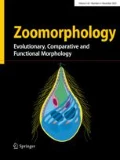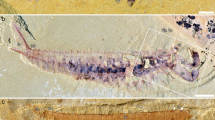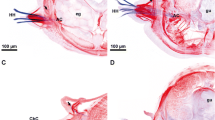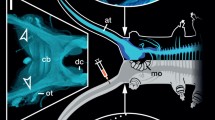Abstract
Chaetae are important structures to facilitate locomotion in annelids. Being at the interface between the organisms and its environment, chaetae are supposed to underlie strong functional constraints to optimize the relation between structure and function. As such chaetae are potentially susceptible for convergent evolution. On the other hand, chaetae gained enormous taxonomic importance due to their conservative structure in species and supraspecific taxa which reasonably can only be explained by strong evolutionary constrains that conserve their structure. In this paper, we study the chaetation and chaetogenesis in two species of Maldanidae, Clymenura clypeata Saint-Joseph 1894 and Johnstonia clymenoides Quatrefages 1866 to unravel conservative traits in their structure and development. In a literature survey across maldanids, we address questions on the ontogenetic variation, on homology and on the phylogenetic significance especially of the bearded hooked neurochaetae. We provide evidence that functionally constraint ontogenetic variation overlies historically (phylogenetically) constraint expression of structural information and can show that within maldanids a variety of different chaetal types must be homologous due to their ontogenetic continuity. Furthermore, we use chaetation and chaetal characters to discuss the subgroup relationships within Maldanomorpha in the light of recent cladistics analyses based on morphological and molecular data. This study shows that functional considerations need to use phylogenies as backbone.












Similar content being viewed by others
References
Arwidsson I (1906) Studien über die skandinavischen und arktischen Maldaniden nebst Zusammenstellung der übringen bisher bekannten Arten dieser Familie. Dissertation, University of Uppsala
Bartolomaeus T (1995a) Structure and formation of the uncini in Pectinaria koreni, Pectinaria auricoma (Terebellida) and Spirorbis spirorbis (Sabellida): implications for annelid phylogeny and the position of the Pogonophora. Zoomorphology 115:161–177
Bartolomaeus T (1995b) Zur Ultrastruktur von Psammodrilus balanoglossoides: Hypothesen zur Stellung der Psammodrilida innerhalb der Annelida. Microfauna Mar 10:295–303
Bartolomaeus T (1998) Chaetogenesis in polychaetous Annelida: significance for annelid systematics and the position of the Pogonophora. Zoology 100:348–364
Bartolomaeus T (2002) Structure and formation of thoracic and abdominal uncini in Fabricia stellaris (Müller 1774)—implication for the evolution of Sabellida (Annelida). Zool Anz 241:1–17
Bartolomaeus T, Meyer K (1997) Development and phylogenetic significance of hooked setae in Arenicolidae (Polychaeta, Annelida). Invertebr Biol 116:227–242
Bleidorn C, Hausen H (2007) Axiothella isocirra, a new species of Maldanidae (Annelida: Polychaeta) from Belize. Proc Biol Soc Wash 120:49–55
Bleidorn C, Vogt L, Bartolomaeus T (2003) New insights into polychaete phylogeny (Annelida) inferred from 18S rDNA sequences. Mol Phylogenet Evol 29:279–288
Blumer MJF, Gahleitner P, Narzt T et al (2002) Ribbons of semithin sections: an advanced method with a new type of diamond knife. J Neurosci Methods 120:11–16
Bouligand Y (1967) Les soies et les cellules associées chez deux Annélides Polychètes. Zeitschrift für Zellforsch. und mikroskopische Anat 79:332–363
De Assis JE, Christoffersen ML (2011) Phylogenetic relationships within Maldanidae (Capitellida, Annelida), based on morphological characters. Syst Biodivers 9:233–245
de Matos Nogueira JM, Fitzhugh K, Hutchings P (2013) The continuing challenge of phylogenetic relationships in Terebelliformia (Annelida: Polychaeta). Invertebr Syst 27(2):186–238
Fauchald K (1977) The polychaete worms: Definitions and keys to the orders, families and genera. Nat Hist Mus Los Angeles County Sci Ser 28:1–188
Fitzhugh K (1991) Uncini and the anchor-function hypothesis: empirical tests and causal explanations. Bull Mar Sci 48:574–583
Green KD (1997) Petaloclymene pacifica, a new genus and species of Maldanidae (Annelida: Polychaeta). Bull Mar Sci 60:235–239
Grobe P, Vogt L (2009) Morph. D. Base 2.0. In: A public date base Morphol. Data, metadata, phylogenetic matrices. http://www.morphdbase.de
Hausen H (2005) Chaetae and chaetogenesis in polychaetes (Annelida). Hydrobiologia 535–536:37–52
Hausen H, Bleidorn C (2006) Significance of chaetal arrangement for maldanid systematics (Annelida, Maldanidae). Sci Mar 70(S3):75–79
Holthe T (1986) Evolution, systematics and distribution of the Polychaeta Terebellomorpha, with a catalogue of the taxa and a bibliography. Gunneria 55:1–236
Imajima M, Shiraki Y (1982) Maldanidae (Annelida: Polychaeta) from Japan (Part 1). Bull Natl Sci Museum Tokyo 8(1):7–46
Koide Y, Hasan I, Asanuma A, Fujii Y, Ogawa Y, Kobayashi H, Ozeki Y (2015) Expression of various types of glycans in the lugworm. Ann Mar Biol Res 2(1):1005
Kongsrud JA, Rapp HT (2012) Nicomache (Loxochona) lokii sp. nov. (Annelida: Polychaeta: Maldanidae) from the Loki’s Castle vent field: an important structure builder in an Arctic vent system. Polar Biol 35:161–170
Kremer JR, Mastronarde DN, McIntosh JR (1996) Computer visualization of three-dimensional image data using IMOD. J Struct Biol 116:71–76
Merz RA (2015) Textures and traction: how tube-dwelling polychaetes get a leg up. Inv Biol 134:61–77
Merz RA, Woodin SA (2000) Hooked setae : tests of the anchor hypothesis. Invertebr Biol 19:67–82
Merz R, Woodin S (2006) Polychaete chaetae: function, fossils, and phylogeny. Integr Comp Biol 46:481–496
Meyer K, Bartolomaeus T (1996) Ultrastructure and formation of the hooked setae in Owenia fusiformis delle Chiaje, 1842: implications for annelid phylogeny. Can J Zool 74:2143–2153
Meyer R, Bartolomaeus T (1997) Ultrastruktur und Morphogenese der Hakenborsten bei Psammodrilus balanoglossoides—Bedeutung für die Stellung der Psammodrilida (Annelida). Microfauna Mar 11:87–113
Meyer C, Westheide W (1997) Boguea panwaensis, a new species from Thailand: the first member of the Bogueinae (Polychaeta: Matdanidae) to be found outside northeast America. Proc Biol Soc Wash 110:203–209
O’Clair R, Cloney R (1974) Patterns of morphogenesis mediated by dynamic microvilli: chaetogenesis in Nereis vexillosa. Cell Tissue Res 151:141–157
Ogawa Y, Kimura S, Wada M (2011) Electron diffraction and high-resolution imaging on highly-crystalline β-chitin microfibril. J Struct Biol 176:83–90
Pilgrim M (1977) The functional morphology and possible taxonomic significance of the parapodia of the maldanid polychaetes Clymenella torquata and Euclymene oerstedi. J Morphol 152:281–302
Rouse GW, Pleijel F (2001) Polychaetes. Oxford University Press, Oxford
Rousset V, Pleijel F, Rouse G et al (2007) A molecular phylogeny of annelids. Cladistics 22:1–23
Schroeder P (1984) Chaetae. In: Bereiter-Hahn J, Matoltsy AG, Richards KS (eds) Biol. Integument SE—18. Springer, Berlin Heidelberg, pp 297–309
Souza CP, Almeida BC, Colwell RR, Rivera IN (2011) The importance of chitin in the marine environment. Mar Biotec 13:823–830
Specht A, Westheide W (1988) Intra-and interspecific ultrastructural character variation: the chaetation of the Microphthalmus listensis species group (Polychaeta, Hesionidae). Zoomorphology 107:371–376
Struck TH, Schult N, Kusen T et al (2007) Annelid phylogeny and the status of Sipuncula and Echiura. BMC Evol Biol 7:57
Struck TH, Paul C, Hill N et al (2011) Phylogenomic analyses unravel annelid evolution. Nature 471:95–98
Tilic E, Hausen H, Bartolomaeus T (2014) Chaetal arrangement and chaetogenesis of hooded hooks in Lumbrineris (Scoletoma) fragilis and Lumbrineris tetraura (Eunicida, Annelida). Invertebr Biol 133:354–370
Tilic E, Lehrke J, Bartolomaeus T (2015) Homology and evolution of the Chaetae in Echiura (Annelida). PLoS One 10(3):e0120002
Weigert A, Helm C, Meyer M et al (2014) Illuminating the base of the annelid tree using transcriptomics. Mol Biol Evol 31(6):1391–1401
Wolf PS (1983) A revision of the bogueidae and its reduction to bogueinae a subfamily of maldanidae polychaeta. Proc Biol Soc Wash 96:238–249
Woodin SA, Merz RA (1987) Holding on by their hooks: anchors for worms. Evolution 41(2):427–432
Acknowledgments
We express our gratitude to the staff of the Station de Biologie Marine in Concarneau for years of hospitality and support of our research. We would also like to thank Tatjana Bartz and Claudia Müller for technical support. Our thanks are also due to two anonymous referees. Their efforts increased the quality of this paper.
Conflict of interest
Author declare that they have no conflict of interest.
Ethical standard
We neither used endangered species nor were the investigated animals collected in protected areas. All animals were collected with the permission of the local marine biological stations: the Station Biologie Marine, Concarneau (France), and the Station Marine d’ Arcachon (France). All applicable international, national and/or institutional guidelines for the care and use of animals were followed. The authors received no specific funding for this work.
Author information
Authors and Affiliations
Corresponding author
Additional information
Communicated by A. Schmidt-Rhaesa.
Rights and permissions
About this article
Cite this article
Tilic, E., von Döhren, J., Quast, B. et al. Phylogenetic significance of chaetal arrangement and chaetogenesis in Maldanidae (Annelida). Zoomorphology 134, 383–401 (2015). https://doi.org/10.1007/s00435-015-0272-9
Received:
Revised:
Accepted:
Published:
Issue Date:
DOI: https://doi.org/10.1007/s00435-015-0272-9




